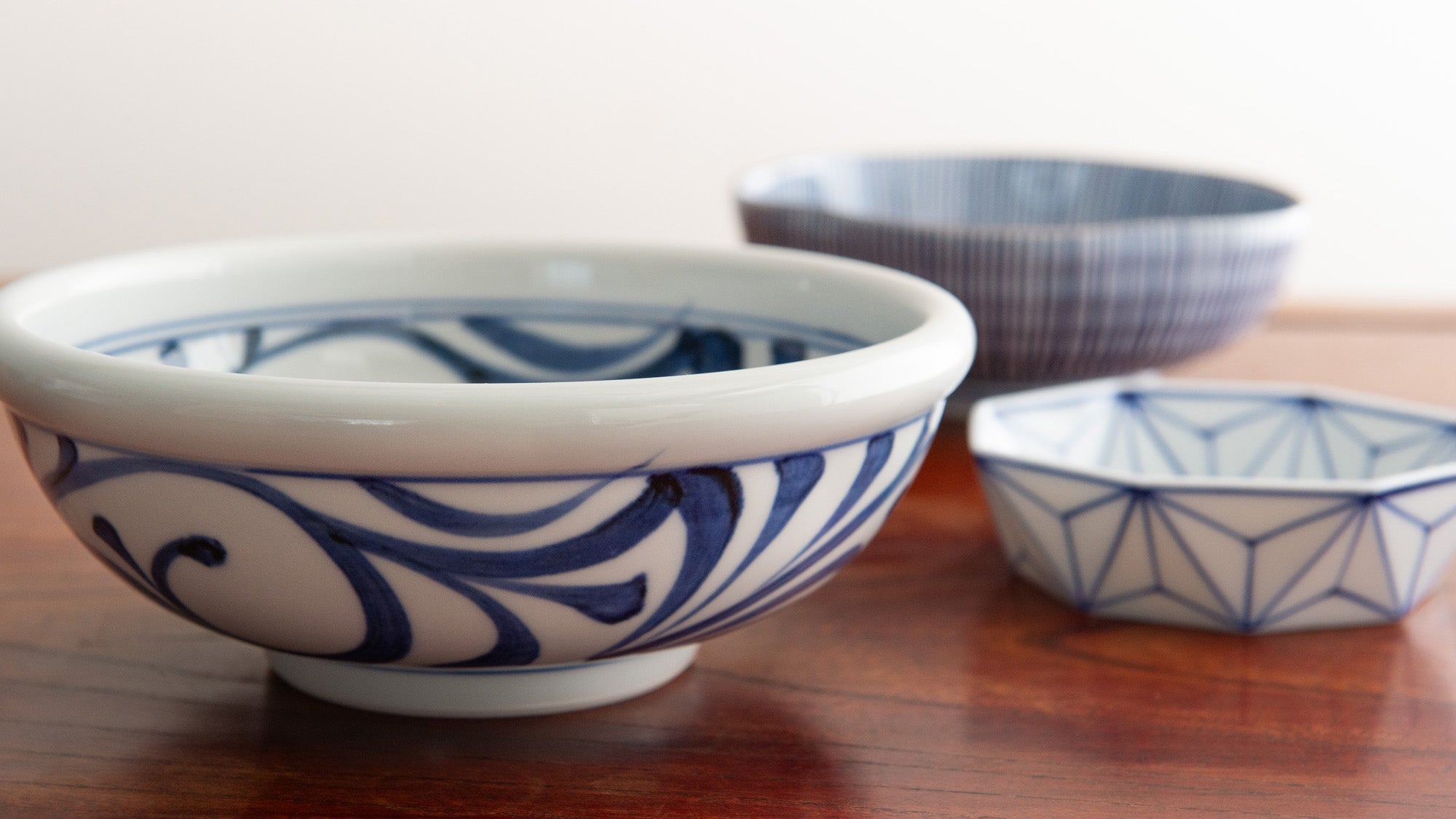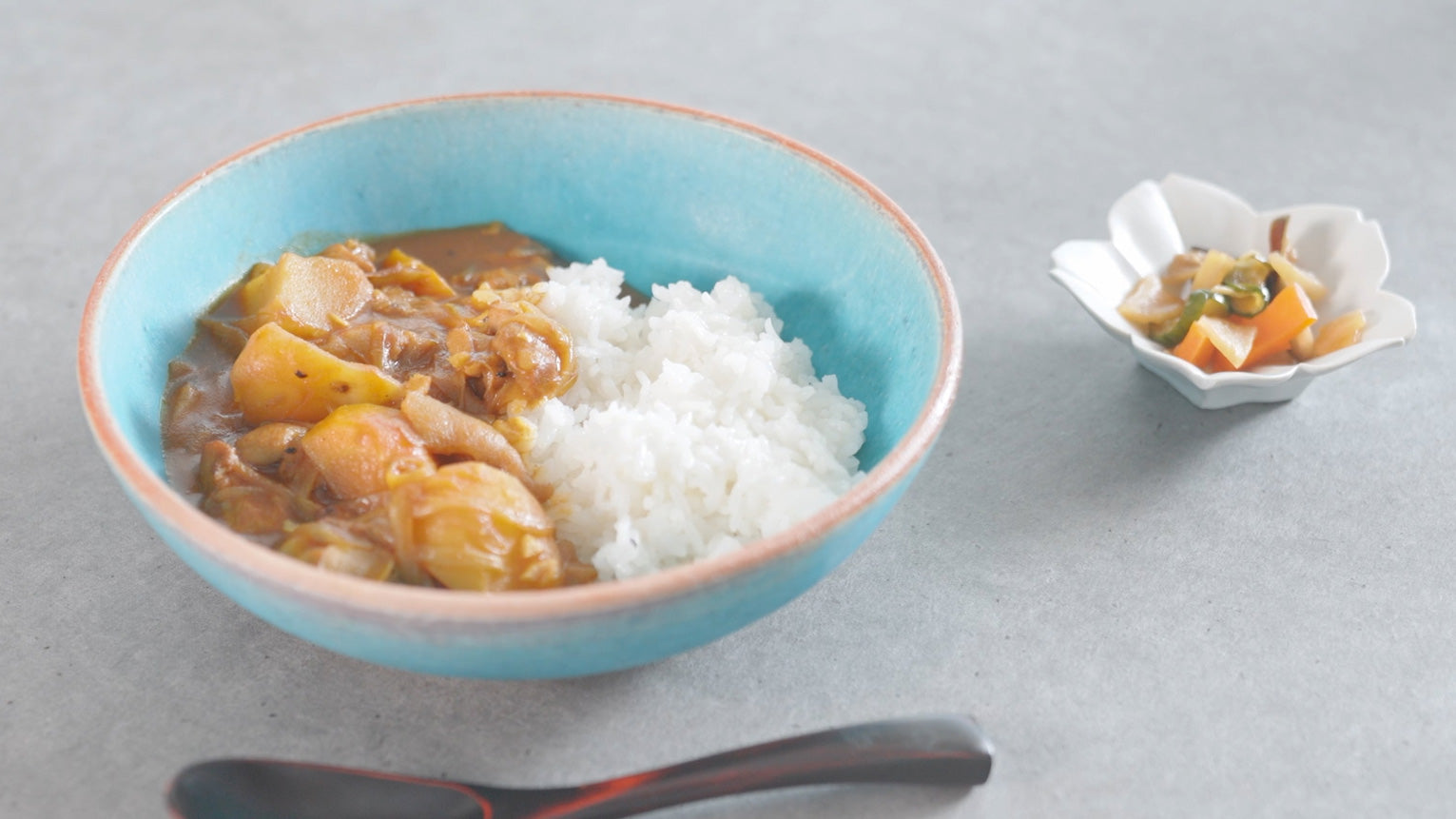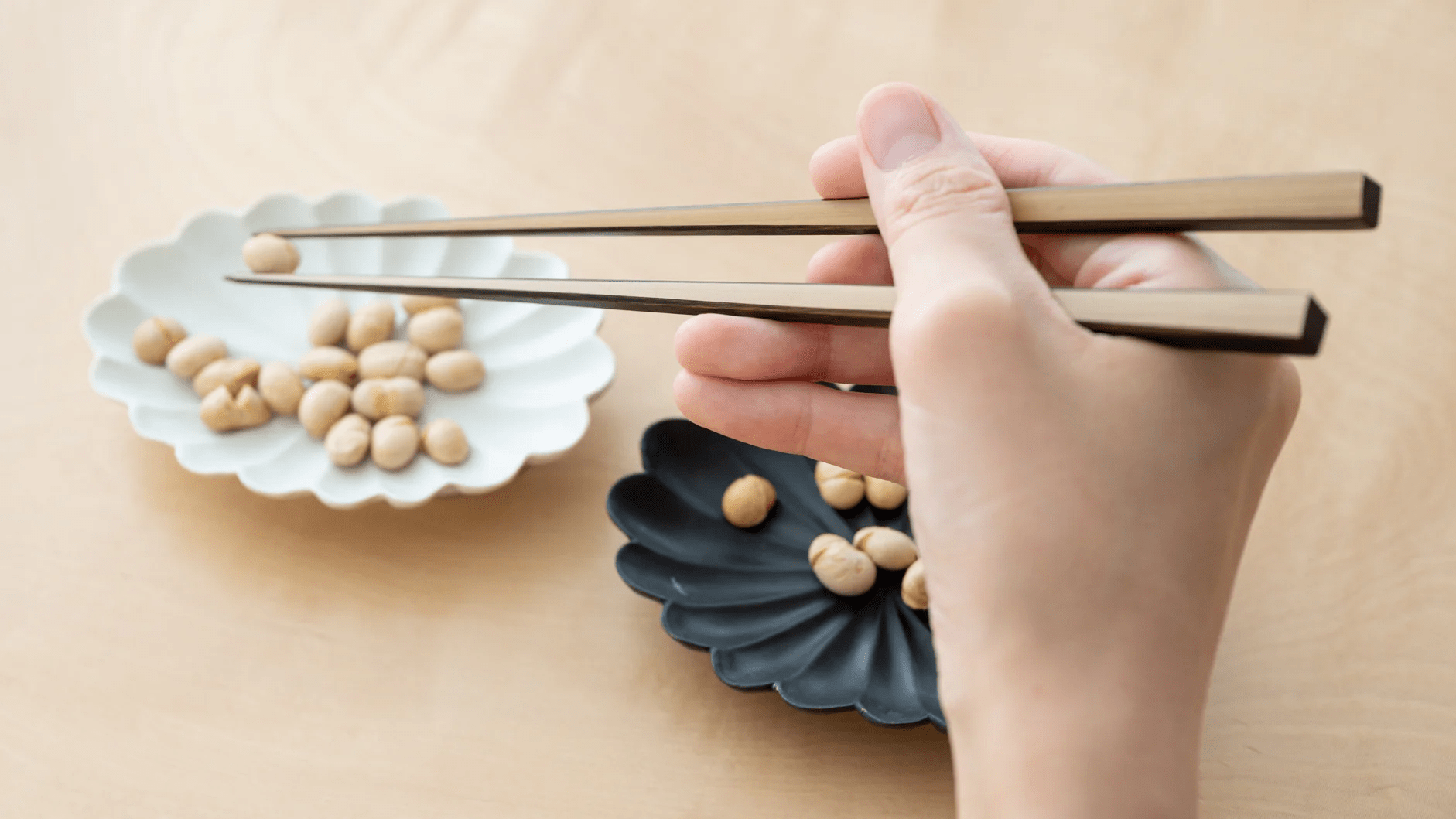
What is Sometsuke?
Written by Team MUSUBI
Sometsuke is a traditional porcelain decorating technique that originated in China and later spread throughout Asia and Europe. Using a cobalt-based pigment, artisans paint designs onto a bisque-fired, unglazed porcelain surface, then apply a clear glaze and fire the piece at high temperatures to bring out its vivid blue finish.
Japanese sometsuke tableware is especially loved by fans of Japanese ceramics—not only for its clean, striking beauty but also for how naturally it complements Japanese cuisine.
In this article, we’ll take a closer look at the refreshing, summery charm of sometsuke.
tables of contents
"Blue and White Porcelain" in Japan

Sometsuke means "to dye" in Japanese. It is said that the name came about because of its similarity to the deep blue color of indigo dyeing in Japan. Pieces painted entirely in blue on a white background were thought to resemble an indigo-dyed kimono.
In the Japanese technique, underglaze cobalt oxide pigment named gosu is used on a bisque-fired, unglazed ceramic body, and a transparent glaze is applied on top to produce a dark blue color. When fired, the cobalt is baked into the glassy substance of the glaze so that it is no longer toxic.
The appeal of sometsuke lies in the harmony between the porcelain’s soft, translucent white surface and the vivid cobalt blue designs. The contrast between these two tones is both striking and serene, refined yet understated. This timeless style of decoration remains a beloved classic in Japanese porcelain, continuing to captivate admirers both in Japan and abroad.
History of Sometsuke

For centuries, producing porcelain domestically was a long-held dream in Japan. That dream began to take form in the early 17th century, when Korean potter Le Sanpei (Yi Sam-pyeong) discovered porcelain stone in the hills of Izumiyama, in what is now Saga Prefecture. This discovery marked the beginning of Japan’s porcelain tradition. Le Sanpei established the foundation for Arita ware, which would go on to be exported from the nearby port of Imari, thus earning the name Imari ware.
Sometsuke was introduced to Japan around this time. It was initially modeled after Chinese blue-and-white porcelain, particularly the styles developed in Jingdezhen during the late Yuan Dynasty (1271–1368 CE). Before reaching Japan, the technique had also spread to the Korean peninsula during the early Yi Dynasty (14th–19th century).
In its early Japanese form, sometsuke closely imitated Chinese designs, often covering the entire surface with intricate decoration. Over time, however, Japanese artisans began to favor a more restrained aesthetic, leaving areas of blank white porcelain and often featuring floral motifs.
As porcelain became more widely used in everyday life, especially during the Edo period (1603–1868 CE), sometsuke patterns grew simpler and more practical. Geometric motifs and repeated brushwork became common, offering a quiet elegance suited to both daily meals and formal settings.
Though the pigments and styles have evolved, especially with the introduction of chemical cobalt from Europe in the Meiji era (1868–1912 CE), the essence of sometsuke remains unchanged. Its vivid blue continues to shine against soft white porcelain, a timeless expression of Japanese craftsmanship and aesthetic sensibility.
Techniques of Sometsuke

The sometsuke technique has been passed down through generations, with each region and kiln developing its own approach. However, one common tool across many traditions is the dami brush—a brush with long, flexible bristles used especially when broad, continuous brushwork is needed to cover the surface of a plate or bowl.
The long bristles of the dami can hold a generous amount of gosu, allowing artisans to work fluidly with fewer interruptions to reload pigment. The density and flow of the pigment are adjusted by gently squeezing the bristles with the fingers, offering precise control over line quality and shading.
Gosu is primarily composed of cobalt oxide and is traditionally made by weathering natural cobalt ore into mud, then dissolving it in water. Historically, some kilns also used smalt—a powdered blue glass containing 4–6% cobalt oxide—as a pigment source.
Natural gosu contains trace amounts of impurities, such as iron, which can result in a slightly muted or smoky blue. This subdued tone is often seen as a hallmark of traditional sometsuke ware. Because the composition of gosu varies by region and source, the exact hue of blue in sometsuke pieces can differ greatly, even among works made using the same basic technique.
Exploring Sometsuke by Region
The appeal of sometsuke tableware lies in its subtle yet distinctive beauty. Japanese sometsuke conveys a modest elegance, with simple forms defined by pristine white porcelain and vivid cobalt-blue patterns. This understated charm makes sometsuke perfect for everyday use.
Another highlight of sometsuke is its remarkable versatility with food. Pure white porcelain harmonizes beautifully with virtually any dish, while the cobalt-blue patterns—rarely seen in natural ingredients—create striking visual contrasts, accentuating the colors and textures of food.
As a classic in Japanese dining, serving meals on sometsuke tableware effortlessly adds authenticity and refinement to your table setting.
Moreover, each region producing sometsuke imparts unique characteristics, further enriching this beloved style of tableware.
Arita Ware
Arita ware was the first white porcelain produced in Japan, established in the early 17th century by the Korean potter Le Sanpei (Yi Sam-pyeong).
The earliest examples of Arita porcelain are known as ko-Imari, or "early Imari," and often featured sometsuke designs influenced heavily by the Chinese porcelain styles of Jingdezhen. These pieces had a distinctly continental flair, despite their Japanese origin.
Arita porcelain eventually evolved into several notable styles, including Nabeshima and Kakiemon, both highly regarded for their elegance and refinement. Many kilns continue to create works in the original, classic sometsuke style—offering glimpses of the tradition's oldest and most tasteful expressions.
Recommended Arita Ware Kilns
Le Sanpei (Yi Sam-pyeong) Kiln
Le Sanpei Kiln's products have a unique style, with a simplicity and wabi sabi feeling that sets them apart from other Arita ware. As the kiln founded by the pioneer of Japanese porcelain, Le Sanpei Kiln is held in high regard for its deep historical roots and the enduring legacy of craftsmanship passed down through generations. The balance between the bluish, translucent texture of porcelain and the beauty of the margins in the sometsuke painting gives each piece a remarkable presence in any contemporary dining space.
Keizan Kiln
Keizan Kiln specializes in sometsuke and colorful overglaze designs on bright white porcelain made from Amakusa ceramic stone. Each piece is hand-painted, with lively motifs that reflect the artisan’s individual touch.
Hasami Ware
Hasami ware is produced in Hasami, Nagasaki Prefecture, near the border of Arita in Saga. While it shares historical roots with Arita ware, Hasami ware has developed as a more accessible, everyday style of porcelain.
Known for its simple sometsuke patterns and practical forms, Hasami ware is designed for daily use—combining ease, durability, and a modest charm that fits comfortably into modern life.
Recommended Hasami Ware Kilns
Fukuhou Kiln
Fukuhou Kiln is a Hasami ware kiln with over fifty years of history, known for its finely hand-painted sometsuke designs, especially the classic tokusa “horsetail” motif. Each line, no matter how delicate, is drawn with confident precision, reflecting true craftsmanship.
Mikawachi Ware
Mikawachi ware is produced in Mikawachi, Nagasaki prefecture. It has a history of serving the lordship of Hirado Domain for more than 200 years, providing fine Sometsuke porcelain ware.
The shade of blue used in this region is more gentle and lighter, giving a more calming and subtle impression. They are also skilled in creating a very fine gradations of blue in the paintings, from the darker shades to the lighter.
Recommended Mikawachi ware kiln famous for Sometsuke
Kakusho Kiln
A prestigious sometsuke kiln once serving the Hirado Domain—now part of Nagasaki Prefecture—Kakusho Kiln is renowned for its award-winning painting techniques and delicate shading of blue.
Instead of traditional brushstrokes, artisans tilt the brush horizontally, allowing the dye to naturally seep into the bisqued surface. This unique approach results in soft, flowing gradations of blue that lend each piece a calm and refined expression.
Hirado Kohsyo Danemon Kiln
As a direct descendant of Nakazato Ei, a Korean-born potter and one of the founders of Mikawachi ware, Hirado Kohsyo Danemon Kiln has carried on its tradition for over 400 years. Now led by 18th-generation potter Taiyo Nakazato, the kiln is celebrated for its refined sometsuke and chrysanthemum ornamental work on luminous white porcelain.
Mino Ware
Mino ware, produced in Gifu Prefecture, is Japan’s largest ceramics-producing region and is known for its wide range of styles—from rustic stoneware to colorful glazes. While most are associated with earthy textures, Mino also produces porcelain featuring sometsuke designs for practical, everyday use.
Seto Ware
Seto ware, made in Aichi Prefecture, has a long and influential history as one of Japan’s Six Ancient Kilns. In the early 19th century, potter Kato Tamikichi studied porcelain-making in Arita and introduced the technique to Seto, marking the beginning of sometsuke porcelain production in the region.
Seto sometsuke is characterized by its crisp cobalt blue brushwork on smooth white porcelain, often featuring motifs like birds, flowers, or geometric patterns.
SINGAMA
Seto ware, made in Aichi Prefecture, has a long and influential history as one of Japan’s Six Ancient Kilns. In the early 19th century, potter Kato Tamikichi studied porcelain-making in Arita and introduced the technique to Seto, marking the beginning of sometsuke porcelain production in the region.
Seto sometsuke is characterized by its crisp cobalt blue brushwork on smooth white porcelain, often featuring motifs like birds, flowers, or geometric patterns.
Tobe Ware
Known for its iconic arabesque design, Tobe ware is crafted in Ehime Prefecture on the island of Shikoku. Its soft, bluish-white porcelain and expressive sometsuke brushwork had been beloved for centuries.
Shaped by the natural beauty of the Seto Inland Sea region, Tobe ware has a warm, unpretentious appeal. Its simple yet tactile forms pair well with everyday meals, especially for noodles like udon, bringing ease and quiet charm to the dining table.
Recommended Tobe Ware Kilns
Tobe Baizan Kiln
Baizan Kiln is the oldest existing kiln in Tobe City. Since its opening in 1882, the kiln has been inheriting its traditions for over 130 years. Famous for its blue underglaze ware, especially its arabesque pattern, its riffling, versatile design has long been favored not only by home cooks, but also by professional chefs in restaurants.
Tobe Higashi Kiln
Higashi Kiln is known for its glass-like smoothness and gentle, pastel-colored designs that resemble watercolor paintings, offering a fresh take on traditional Tobe ware. The painting is done by artist Ohigashi Alyne, whose style brings a soft, modern elegance to each piece.
Kutani Ware
Kutani ware, from Ishikawa Prefecture in Japan’s Hokuriku region, is best known for its colorful gosai (five-color) overglaze style, but sometsuke also has deep roots in its tradition.
In particular, ai-Kutani uses only indigo blue to create expressive, brush-painted designs on firm white porcelain. The contrast gives each piece a strong, elegant presence—like painting with cobalt on a canvas of white.
Recommended Kutani Ware Kiln
Choemon Kiln
Founded in 1879 in Nomi, Ishikawa Prefecture, Choemon Kiln carries on the rich heritage of East Asian porcelain through finely handcrafted tableware. Known for its deep indigo sometsuke and vibrant gosai overglaze, the kiln creates pieces that blend tradition with bold, expressive design.
From bold brushwork to delicate gradations, from centuries-old kilns to contemporary studios, sometsuke continues to evolve while honoring its roots, while each region offers its own take on this timeless craft. Explore our full collection and find the piece that speaks to your table—and your style.























2 comments
Dear Tina-Marie,
Thank you for reaching out. We appreciate your interest in learning the sumetsuke technique during your visit to Tokyo. Our concierge team will be in touch via email regarding your inquiry about sumetsuke workshops.
Wishing you a wonderful visit to Japan, and please do not hesitate to contact us for any other inquiries.
Best regards,
Team Musubi
Team Musubi
Good day
Can you advise where I can learn the sumetsuke technique.
I am an experienced ceramic artist and I am visiting Tokyo in June.
I am hoping to do a 1-3 day workshop to learn sumetsuke, preferably not too far from Tokyo.
Hoping you have suggestions
Kindest regards
Tina-Marie
Ps. To see my work, please refer to my web page www.tina-mariemalherbe or my instagram @tinamariemalherbe.
Tina-Marié Malherbe
Leave a comment
This site is protected by hCaptcha and the hCaptcha Privacy Policy and Terms of Service apply.